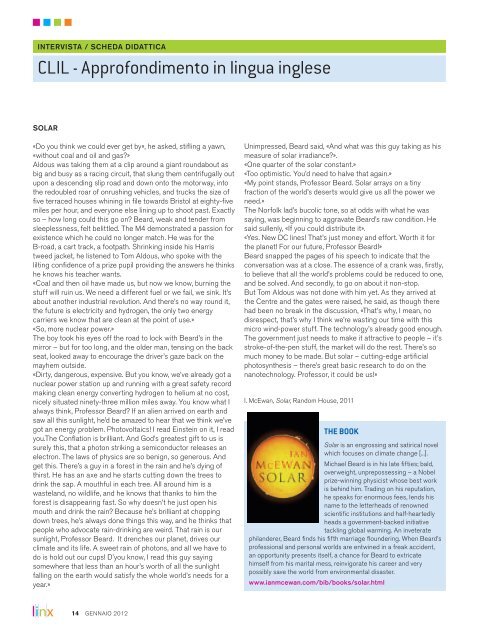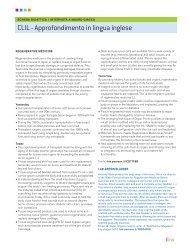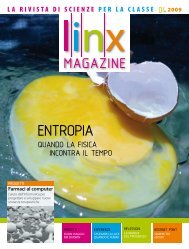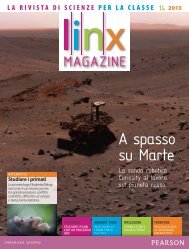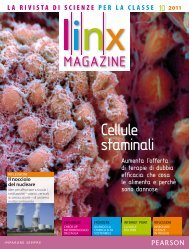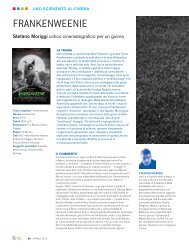Scarica la SCHEDA DIDATTICA in formato pdf - Linx Magazine
Scarica la SCHEDA DIDATTICA in formato pdf - Linx Magazine
Scarica la SCHEDA DIDATTICA in formato pdf - Linx Magazine
Create successful ePaper yourself
Turn your PDF publications into a flip-book with our unique Google optimized e-Paper software.
<strong>in</strong>TerviSTa / Scheda didaTTica<br />
Clil - approfondimento <strong>in</strong> l<strong>in</strong>gua <strong>in</strong>glese<br />
So<strong>la</strong>r<br />
«Do you th<strong>in</strong>k we could ever get by», he asked, stifl<strong>in</strong>g a yawn,<br />
«without coal and oil and gas?»<br />
aldous was tak<strong>in</strong>g them at a clip around a giant roundabout as<br />
big and busy as a rac<strong>in</strong>g circuit, that slung them centrifugally out<br />
upon a descend<strong>in</strong>g slip road and down onto the motorway, <strong>in</strong>to<br />
the redoubled roar of onrush<strong>in</strong>g vehicles, and trucks the size of<br />
five terraced houses wh<strong>in</strong><strong>in</strong>g <strong>in</strong> file towards Bristol at eighty-five<br />
miles per hour, and everyone else l<strong>in</strong><strong>in</strong>g up to shoot past. exactly<br />
so – how long could this go on? Beard, weak and tender from<br />
sleeplessness, felt belittled. The M4 demonstrated a passion for<br />
existence which he could no longer match. He was for the<br />
B-road, a cart track, a footpath. Shr<strong>in</strong>k<strong>in</strong>g <strong>in</strong>side his Harris<br />
tweed jacket, he listened to Tom aldous, who spoke with the<br />
lilt<strong>in</strong>g confidence of a prize pupil provid<strong>in</strong>g the answers he th<strong>in</strong>ks<br />
he knows his teacher wants.<br />
«Coal and then oil have made us, but now we know, burn<strong>in</strong>g the<br />
stuff will ru<strong>in</strong> us. We need a different fuel or we fail, we s<strong>in</strong>k. it’s<br />
about another <strong>in</strong>dustrial revolution. and there’s no way round it,<br />
the future is electricity and hydrogen, the only two energy<br />
carriers we know that are clean at the po<strong>in</strong>t of use.»<br />
«So, more nuclear power.»<br />
The boy took his eyes off the road to lock with Beard’s <strong>in</strong> the<br />
mirror – but for too long, and the older man, tens<strong>in</strong>g on the back<br />
seat, looked away to encourage the driver’s gaze back on the<br />
mayhem outside.<br />
«Dirty, dangerous, expensive. But you know, we’ve already got a<br />
nuclear power station up and runn<strong>in</strong>g with a great safety record<br />
mak<strong>in</strong>g clean energy convert<strong>in</strong>g hydrogen to helium at no cost,<br />
nicely situated n<strong>in</strong>ety-three million miles away. You know what i<br />
always th<strong>in</strong>k, Professor Beard? if an alien arrived on earth and<br />
saw all this sunlight, he’d be amazed to hear that we th<strong>in</strong>k we’ve<br />
got an energy problem. Photovoltaics! i read e<strong>in</strong>ste<strong>in</strong> on it, i read<br />
you.The Conf<strong>la</strong>tion is brilliant. and god’s greatest gift to us is<br />
surely this, that a photon strik<strong>in</strong>g a semiconductor releases an<br />
electron. The <strong>la</strong>ws of physics are so benign, so generous. and<br />
get this. There’s a guy <strong>in</strong> a forest <strong>in</strong> the ra<strong>in</strong> and he’s dy<strong>in</strong>g of<br />
thirst. He has an axe and he starts cutt<strong>in</strong>g down the trees to<br />
dr<strong>in</strong>k the sap. a mouthful <strong>in</strong> each tree. all around him is a<br />
waste<strong>la</strong>nd, no wildlife, and he knows that thanks to him the<br />
forest is disappear<strong>in</strong>g fast. So why doesn’t he just open his<br />
mouth and dr<strong>in</strong>k the ra<strong>in</strong>? Because he’s brilliant at chopp<strong>in</strong>g<br />
down trees, he’s always done th<strong>in</strong>gs this way, and he th<strong>in</strong>ks that<br />
people who advocate ra<strong>in</strong>-dr<strong>in</strong>k<strong>in</strong>g are weird. That ra<strong>in</strong> is our<br />
sunlight, Professor Beard. it drenches our p<strong>la</strong>net, drives our<br />
climate and its life. a sweet ra<strong>in</strong> of photons, and all we have to<br />
do is hold out our cups! D’you know, i read this guy say<strong>in</strong>g<br />
somewhere that less than an hour’s worth of all the sunlight<br />
fall<strong>in</strong>g on the earth would satisfy the whole world’s needs for a<br />
year.»<br />
14 gennaio 2012<br />
Unimpressed, Beard said, «and what was this guy tak<strong>in</strong>g as his<br />
measure of so<strong>la</strong>r irradiance?».<br />
«one quarter of the so<strong>la</strong>r constant.»<br />
«Too optimistic. You’d need to halve that aga<strong>in</strong>.»<br />
«My po<strong>in</strong>t stands, Professor Beard. So<strong>la</strong>r arrays on a t<strong>in</strong>y<br />
fraction of the world’s deserts would give us all the power we<br />
need.»<br />
The norfolk <strong>la</strong>d’s bucolic tone, so at odds with what he was<br />
say<strong>in</strong>g, was beg<strong>in</strong>n<strong>in</strong>g to aggravate Beard’s raw condition. He<br />
said sullenly, «if you could distribute it».<br />
«Yes. new DC l<strong>in</strong>es! That’s just money and effort. Worth it for<br />
the p<strong>la</strong>net! For our future, Professor Beard!»<br />
Beard snapped the pages of his speech to <strong>in</strong>dicate that the<br />
conversation was at a close. The essence of a crank was, firstly,<br />
to believe that all the world’s problems could be reduced to one,<br />
and be solved. and secondly, to go on about it non-stop.<br />
But Tom aldous was not done with him yet. as they arrived at<br />
the Centre and the gates were raised, he said, as though there<br />
had been no break <strong>in</strong> the discussion, «That’s why, i mean, no<br />
disrespect, that’s why i th<strong>in</strong>k we’re wast<strong>in</strong>g our time with this<br />
micro w<strong>in</strong>d-power stuff. The technology’s already good enough.<br />
The government just needs to make it attractive to people – it’s<br />
stroke-of-the-pen stuff, the market will do the rest. There’s so<br />
much money to be made. But so<strong>la</strong>r – cutt<strong>in</strong>g-edge artificial<br />
photosynthesis – there’s great basic research to do on the<br />
nanotechnology. Professor, it could be us!»<br />
i. Mcewan, So<strong>la</strong>r, Random House, 2011<br />
the Book<br />
So<strong>la</strong>r is an engross<strong>in</strong>g and satirical novel<br />
which focuses on climate change [...].<br />
Michael Beard is <strong>in</strong> his <strong>la</strong>te fifties; bald,<br />
overweight, unprepossess<strong>in</strong>g – a nobel<br />
prize-w<strong>in</strong>n<strong>in</strong>g physicist whose best work<br />
is beh<strong>in</strong>d him. Trad<strong>in</strong>g on his reputation,<br />
he speaks for enormous fees, lends his<br />
name to the letterheads of renowned<br />
scientific <strong>in</strong>stitutions and half-heartedly<br />
heads a government-backed <strong>in</strong>itiative<br />
tackl<strong>in</strong>g global warm<strong>in</strong>g. an <strong>in</strong>veterate<br />
phi<strong>la</strong>nderer, Beard f<strong>in</strong>ds his fifth marriage flounder<strong>in</strong>g. When Beard’s<br />
professional and personal worlds are entw<strong>in</strong>ed <strong>in</strong> a freak accident,<br />
an opportunity presents itself, a chance for Beard to extricate<br />
himself from his marital mess, re<strong>in</strong>vigorate his career and very<br />
possibly save the world from environmental disaster.<br />
www.ianmcewan.com/bib/books/so<strong>la</strong>r.html
ora tocca a te<br />
doMande e aTTiviTà<br />
Prova a realizzare questa semplice<br />
attività, che ti consentirà di vedere gli<br />
effetti del<strong>la</strong> fotos<strong>in</strong>tesi su alcuni pezzetti<br />
circo<strong>la</strong>ri di foglia, che chiameremo<br />
dischetti.<br />
Come forse avrai notato, di solito<br />
nell’acqua le foglie galleggiano. Questo<br />
accade per <strong>la</strong> presenza di gas nel<br />
mesofillo fogliare, che è <strong>formato</strong> da<br />
cellule tondeggianti disposte <strong>in</strong> modo<br />
irrego<strong>la</strong>re, con ampi spazi <strong>in</strong>tercellu<strong>la</strong>ri.<br />
Se questi spazi vengono riempiti con una<br />
soluzione, <strong>la</strong> densità complessiva<br />
aumenta e <strong>la</strong> foglia affonda.<br />
Durante l’attività, <strong>in</strong>filtrerai i dischetti con<br />
una soluzione contenente una picco<strong>la</strong><br />
quantità di bicarbonato di sodio<br />
(naHCo 3): questo ne aumenterà <strong>la</strong><br />
densità, facendoli affondare.<br />
Poco dopo, però, potrai osservare che<br />
ricom<strong>in</strong>ceranno a galleggiare. Questo<br />
perché gli ioni bicarbonato servono come<br />
fonte alternativa di biossido di carbonio<br />
per <strong>la</strong> fotos<strong>in</strong>tesi, che procedendo<br />
ri<strong>la</strong>scerà ossigeno, il quale a sua volta,<br />
accumu<strong>la</strong>ndosi all’<strong>in</strong>terno del<strong>la</strong> foglia, ne<br />
modificherà <strong>la</strong> galleggiabilità.<br />
La velocità con cui i dischi risaliranno <strong>in</strong><br />
superficie ti darà una misura <strong>in</strong>diretta<br />
del<strong>la</strong> velocità con cui avviene <strong>la</strong><br />
fotos<strong>in</strong>tesi.<br />
1. Prepara una soluzione di 300 ml di<br />
bicarbonato di sodio allo 0,2% mettendo<br />
circa 1/8 di un cucchia<strong>in</strong>o da tè di<br />
bicarbonato <strong>in</strong> 300 ml d’acqua. aggiungi<br />
al<strong>la</strong> soluzione una goccia di sapone<br />
liquido che, bagnando <strong>la</strong> superficie<br />
idrofobica del<strong>la</strong> foglia, permetterà al<strong>la</strong><br />
soluzione di penetrare al suo <strong>in</strong>terno.<br />
2. Con una perforatrice per fogli, taglia<br />
20 dischetti da una foglia (i dischetti<br />
avranno all’<strong>in</strong>circa un diametro di 5 mm),<br />
forando<strong>la</strong> lontano dal<strong>la</strong> nervatura<br />
centrale: dieci per il gruppo sperimentale<br />
e altrettanti per il gruppo di controllo. La<br />
foglia da utilizzare deve essere liscia, non<br />
pelosa e non troppo spessa.<br />
3. Prendi una sir<strong>in</strong>ga, rimuovi lo stantuffo<br />
e <strong>in</strong>serisci all’<strong>in</strong>terno i dischetti di foglia.<br />
Rimetti lo stantuffo e abbassalo f<strong>in</strong>ché<br />
resta solo una picco<strong>la</strong> quantità d’aria<br />
(


